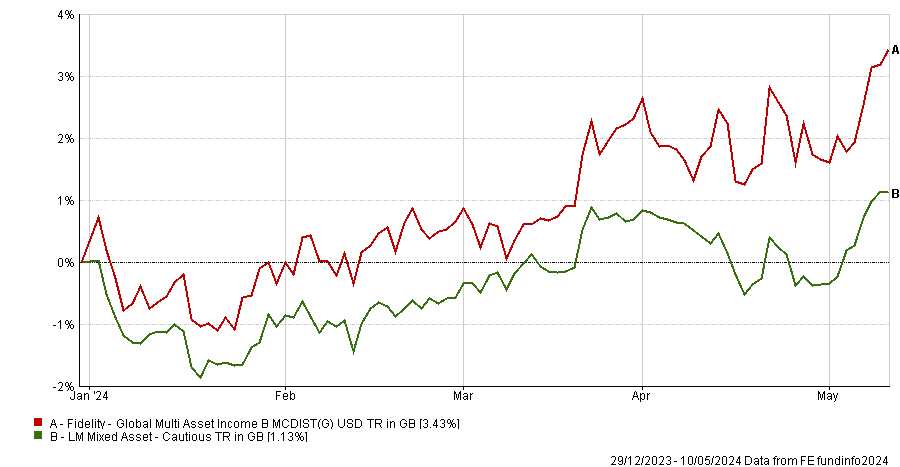Talib Sheikh has spent 2024 moving Fidelity International’s $7.4bn multi-asset income portfolios out of government bonds, going overweight Europe and enhancing the investment process, after replacing Eugene Philalithis at the start of this year.
One of the first moves Sheikh made was to reduce interest rate risk and duration from three and a half years to one year in the $5.5bn FF Global Multi-Asset Income fund and its stablemates. “All we have left is short-dated plays,” he said.
Government bonds are expensive and risk additive, he explained. As a result, diversification has become harder during the past 18 months because “government bonds and investment grade credit haven’t really been that safe”. Currencies can be a useful diversifier, he added.
In the fixed income portion of his portfolios, Sheikh favours corporate hybrids in Europe. He has invested in contingent convertibles (CoCos), also known as additional tier 1 (AT1s) bonds, which sit at the bottom of the debt stack above equities and pay attractive yields in the region of 7.5% for two years of duration.
He has modest exposure to infrastructure using investment trusts, which have had “a pretty torrid time” in recent years due to rate hikes. They offer high free cash flows and high dividend yields, many of which are inflation-linked, he said.
Equity exposure is at the top end of his funds’ permissible ranges, at 40% for FIF Multi Asset Income, 60% for FIF Multi Asset Balanced Income and 80% for FIF Multi Asset Income & Growth.
Sheikh, who joined Fidelity from Jupiter Asset Management in October, has been increasing his exposure to core developed market equities where growth is expanding, with an emphasis on continental Europe. “We’re trying to buy more value plays where there is a cushion, where we can see the earnings start to increase from here,” he explained.
Performance of fund year-to-date vs sector

Source: FE Analytics
Sheikh has adjusted the investment process to be more responsive to changing economic scenarios so that the fund is always “relevant”, whatever the macroeconomic outlook.
These changes resulted in Square Mile Investment Consulting & Research removing the Multi-Asset Income fund’s A rating as its analysts would “prefer to see how the combination of the changes to the team and approach progresses over time”. Rayner Spencer Mills Research reaffirmed its rating.
Sheikh said he approaches multi-asset investing in a similar way to his predecessor Philalithis. “The way I think about the world is very connected to the way Fidelity thinks about it,” he explained. “They definitely wanted someone who thought in a similar way to how Eugene built portfolios.”
Nonetheless, he also wants to bring his 25 years of experience to bear. “I’m not just going to copy what Eugene did. I want to try and enhance the process and bring my own experience. Most of that is to do with the idea that we’re in a new regime.”
Sheikh believes the global economy has entered a new regime of regional desynchronisation, higher government deficits and stickier inflation. He thinks inflation will move symmetrically around central banks’ targets, so “sometimes we’ll worry about inflation, sometimes we’ll be worrying about deflation”. The macroeconomic backdrop is oscillating between reflation, where commodities do well, and goldilocks, where equities outperform, he observed.
Between the financial crisis and the Covid pandemic, the global economy moved in sync but more recently, regional economic cycles have become desynchronised. Europe and the UK have experienced mild recessions, China has had “a terrible time” and US economic resilience has surprised on the upside.
This has created greater divergence and therefore more opportunities for asset allocators. “If you’ve been ignoring Europe, long the US, long Japan and short China, you’ve had an amazing three years,” he observed.
Sheikh’s approach to asset allocation is to form a structural view – his outlook for the next six to 12 months – then a shorter-term cyclical view covering six to nine months, which guides tactical shifts. He then analyses what his structural and cyclical forecasts mean for asset prices.
“I think of macro forces as being like a wave going across the global economy. It’ll hit one asset class then another asset class, then another asset class,” he explained. “So what we’re trying to do is think forward how those macro forces are going to be priced across various asset classes.”
The multi-asset portfolios are built using Fidelity funds alongside third-party funds, leveraging recommendations from the in-house manager research team. He also uses derivatives to adjust the asset allocation efficiently and cheaply.
Sheikh’s funds have three objectives: income first, as well as downside protection, plus the prospect of capital growth. He is aiming for volatility to be half that of the equity market and described the investment process as “stable, repeatable and sensible.” His multi-asset funds will not beat returns from equities over 10 years, but “we’re a different animal”, he pointed out. “We’re taking half the risk. There is no free lunch. We’re trying to smooth the ride for investors.”





